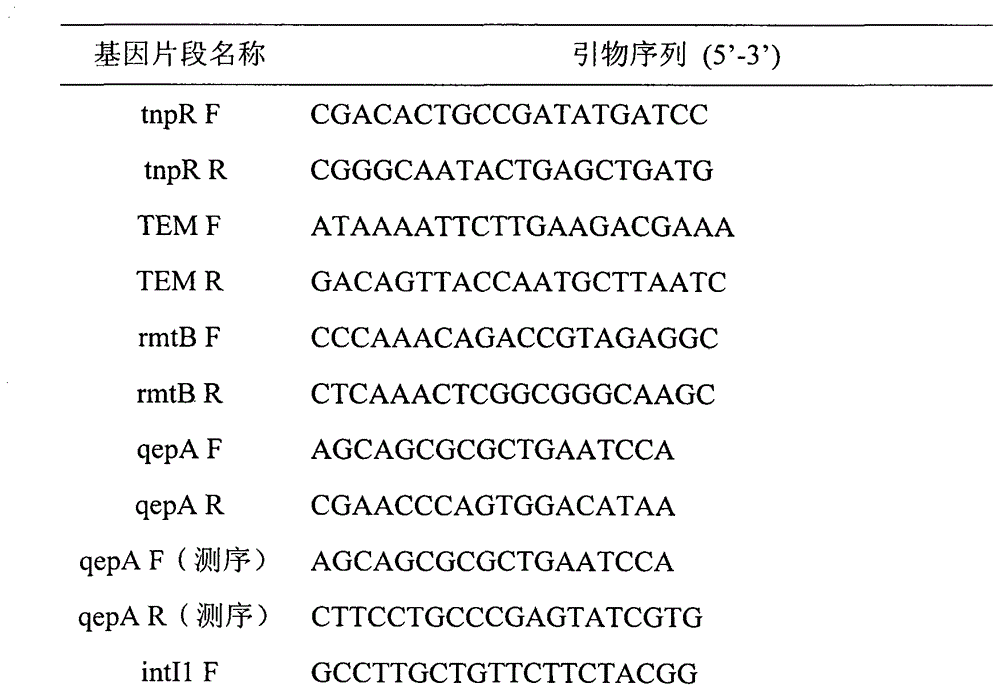Plasmid fragment carrying novel gene qepA3
A plasmid and fragment technology, applied in genetic engineering, plant genetic improvement, microbial-based methods, etc., can solve the problems of low prevalence, transmission and infection, and achieve the effect of preventing explosive epidemics and reducing use
- Summary
- Abstract
- Description
- Claims
- Application Information
AI Technical Summary
Problems solved by technology
Method used
Image
Examples
Embodiment 1
[0025] Embodiment 1 Identification of the plasmid fragment carrying the new gene of qepA3
[0026] 1. Isolation and identification of strain EC3157
[0027] 1.1 Materials
[0028] Bacterial susceptibility card: AST-GN13 from bioMerieux, France. AST-GN13 drug-sensitive types include: amikacin, ampicillin, ampicillin / sulbactam, aztreonam, cefazolin, cefepime, cefotetan, ceftazidime, ceftriaxone, ciproxa Star, ertapenem, gentamicin, imipenem, levofloxacin, nitrofurantoin, piperacillin / tazobactam, tobramycin.
[0029] 1.2 Method
[0030] Apparatus identification: transfer positive bacterial strains from ICU patients of Taizhou Municipal Hospital to blood plates for isolation and culture (at 35°C containing 5% CO 2 Cultivate in the incubator for 16-18h), and then carry out bacterial identification and drug susceptibility test on the VITEK2 machine according to the operating procedures for the isolated pure bacteria.
[0031] Supplementary drug susceptibility test: smear 0.5 Mc...
Embodiment 2
[0051] Example 2 Plasmid transduction experiments to study the function of plasmid fragments carrying the new qepA3 gene
[0052] 1. Method
[0053] (1) The donor strain is EC3157 strain, and the recipient strain is E.coliJ53Az R (resistant to sodium azide). The donor bacteria and recipient bacteria were inoculated on LB plates, respectively, and cultured overnight at 35°C. Pick a single colony and inoculate them in 4 mL of LB broth, and culture at 37°C and 220 r / min until the logarithmic growth phase. Take 0.5 mL of donor and recipient bacteria in 4 mL of LB broth, and culture overnight at 37°C. Zygotes were screened on trypan soy agar (TSA) plates containing sodium azide (300 mg / L) and amifloxacin (0.03 mg / L). Incubate at 35°C for 18-24h. Extract the plasmid of the drug-resistant bacterial strain (the steps are the same as in Example 1), and carry out the detection of the plasmid carrying the qepA3 new gene by the PCR method.
[0054] The primers and sequencing primers...
Embodiment 3
[0065] Example 3 Gene recombination experiment to study the function of the plasmid fragment carrying the qepA3 new gene
[0066] 1. Method
[0067] (1) The PCR product in Example 2 (the nucleotide sequence is SEQIDNO.1) is connected to the pMD19-T vector, and the connection product is added to 100 μl of E.coliJM109 in a competent state for transformation, and the PCR product containing IPTG, X-Gal, Amp Cultivate on a plate, and sequence the plasmids extracted from IPTG, X-Gal, and Amp drug-resistant strains (the steps are the same as in Example 1), and detect whether the plasmid fragment carrying the new qepA3 gene is inserted into the genome. Then clone this segment of sequence into the pET32a vector. The insertion site of this segment of sequence is at the DraI and BamHI restriction sites on the pET32a vector. It is prepared according to conventional methods to obtain the new genes carrying qepA3, rmtB and bla respectively. CTX-M-14 Gene pET32a recombination plasmid. Tran...
PUM
 Login to View More
Login to View More Abstract
Description
Claims
Application Information
 Login to View More
Login to View More - Generate Ideas
- Intellectual Property
- Life Sciences
- Materials
- Tech Scout
- Unparalleled Data Quality
- Higher Quality Content
- 60% Fewer Hallucinations
Browse by: Latest US Patents, China's latest patents, Technical Efficacy Thesaurus, Application Domain, Technology Topic, Popular Technical Reports.
© 2025 PatSnap. All rights reserved.Legal|Privacy policy|Modern Slavery Act Transparency Statement|Sitemap|About US| Contact US: help@patsnap.com



